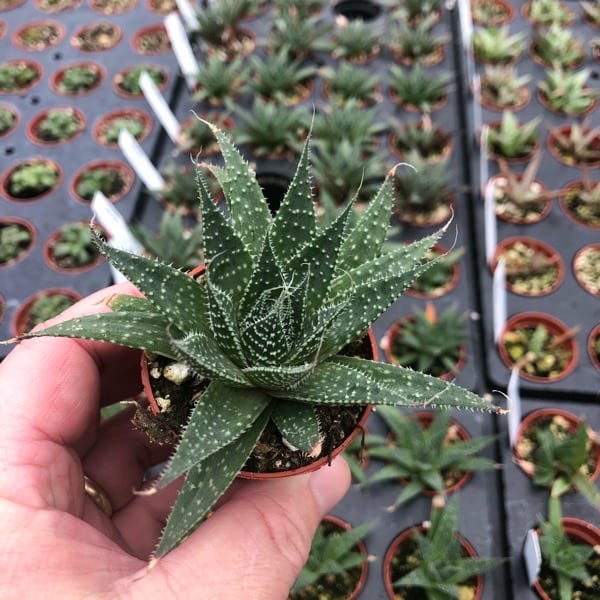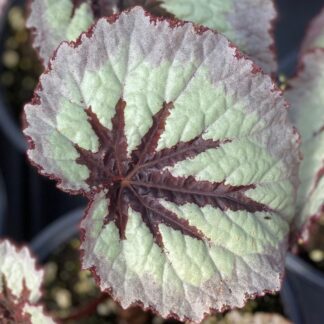Description
Aristaloe aristata (Lace Aloe): A Little Wonder With Big Charm
If you’re looking for a plant that’s as tough as it is beautiful, let me introduce you to Aristaloe aristata, also known as Lace Aloe. This little wonder is a true gift from South Africa’s rugged terrain, and it brings that same spirit of resilience and grace right into your garden or home. With its symmetrical form, delicate “lace” edges, and bold personality, the Lace Aloe is more than just another pretty succulent—it’s a joy to grow and love.
🌿 What Is Lace Aloe?
Let’s start with the basics. Aristaloe aristata is a succulent that grows in a tidy rosette form. It’s part of the Asphodelaceae family, which it shares with more famous cousins like Aloe vera. But this plant has a style all its own.
Its fleshy, dark green leaves are packed with personality—speckled with tiny white dots and edged in soft, hair-like bristles. These delicate “eyelashes” give it that lace-like appearance that inspires its common name.
But don’t let its elegance fool you. Lace Aloe is tough. Like, really tough.
🌸 A Blooming Bonus
One of the most delightful things about Lace Aloe is what happens in late spring or early summer. That’s when it sends up tall, slender flower stalks covered in tubular orange-red blooms.
And here’s the exciting part: these flowers don’t just look pretty—they’re also a magnet for pollinators. Bees, butterflies, and even hummingbirds can’t resist them. So if you’re building a pollinator-friendly garden, this little aloe fits right in.
🪴 Why We Love Lace Aloe
Honestly, there are so many reasons to fall for this plant. But let’s break it down:
-
Compact and Manageable: It won’t outgrow your shelf or crowd out your other plants. Perfect for small spaces.
-
Gorgeous Foliage: The spotted, textured leaves look amazing on their own, even when the plant isn’t flowering.
-
Low Maintenance: If you forget to water it now and then—don’t worry. It can take it.
-
Versatile Display Options: It’s just as happy in a terracotta pot on your windowsill as it is in a sunny rock garden.
-
Cold Hardy for a Succulent: Surprisingly tolerant of cooler temperatures. In USDA zones 8–11, it can grow outdoors year-round.
🌞 Light Requirements
Lace Aloe loves bright light. Outdoors, it thrives in full sun to partial shade. Indoors, give it a sunny windowsill, preferably south or east-facing. While it can tolerate lower light, it won’t grow as compact or vibrant.
If it starts stretching or losing its rich color, that’s your clue it needs more light.
💧 Watering Made Simple
This is where many plant parents fall in love: Lace Aloe is super forgiving when it comes to watering.
Here’s the golden rule: Let the soil dry out completely between waterings.
-
Spring and Summer: Water thoroughly but infrequently. About every 2–3 weeks is usually plenty.
-
Fall and Winter: Cut back even more. Once a month—or less—is often enough.
Overwatering is the number one cause of trouble with this plant. If the leaves start to look mushy or translucent, you might be loving it a bit too much.
🪨 Soil and Potting Tips
Like all succulents, Lace Aloe wants to dry out quickly. That means using:
-
Well-draining soil – Cactus or succulent mix works great.
-
A pot with drainage holes – Essential! Waterlogged roots are a no-go.
You can even mix in a little pumice or perlite to make the soil extra light and airy.
🌡️ Temperature and Humidity
This aloe is tough, but it’s still a succulent. So:
-
Ideal Temps: Between 60–80°F (15–27°C)
-
Cold Tolerance: Can survive brief dips into the 20s°F (-6°C) if it’s dry, but it’s best to bring it inside if frost threatens.
-
Humidity: No special needs. Dry air is totally fine.
If you live in a region with chilly winters, just move it indoors when temperatures drop and place it in a bright spot. It’ll be happy until spring rolls around again.
🧪 Fertilizer (Only If You Feel Like It)
You don’t have to feed your Lace Aloe, but a little boost now and then helps, especially during the growing season.
-
Use a balanced succulent fertilizer diluted to half strength.
-
Fertilize once a month in spring and summer.
-
Skip feeding in fall and winter while the plant rests.
Simple, right?
✂️ Propagation: Sharing the Love
Want more Lace Aloe? This plant practically hands you the opportunity.
It produces offsets, also called “pups,” at the base of the mother plant. When they get big enough:
-
Gently pull or cut them away.
-
Let them dry out for a day or two.
-
Plant in well-draining soil.
-
Water sparingly until roots form.
Before long, you’ll have a whole little aloe family—and maybe even some to share!
🐾 Pet Safety
Now, here’s a quick word of caution.
Lace Aloe, like many aloes, is toxic to cats and dogs if ingested. If you have curious pets who like to nibble, it’s best to keep this plant out of reach.
🌍 A Touch of South Africa in Your Home
It’s kind of amazing to think this plant comes from the rocky grasslands of South Africa. Out there, it survives blazing sun, sudden downpours, and dry spells with ease. Bringing a Lace Aloe into your home or garden is like carrying a little piece of that wild, beautiful landscape with you.
And the best part? It asks for so little in return.
💡 Styling Ideas
Here are some fun ways to show off your Lace Aloe:
-
Windowsill Hero: Place it in a rustic clay pot for a natural, desert-inspired look.
-
Rock Garden Feature: Pair with other low-growing succulents like Sedum or Echeveria.
-
Tabletop Arrangement: Combine with bright pebbles or driftwood in a shallow container.
-
Terrarium Twist: Just make sure it’s open-air with plenty of drainage.
No matter where you put it, the Lace Aloe brings texture, structure, and an irresistible charm.
🌱 Perfect for Beginners
If you’re new to plants, this is one you’ll want in your collection. And if you’re a seasoned grower? You’ll appreciate how effortlessly it fits into your routine.
The Lace Aloe is:
-
Adaptable
-
Beautiful year-round
-
Easy to propagate
-
Pest-resistant
-
Practically unkillable (if you don’t overwater)
It’s one of those plants that gives you so much while asking for very little.
Ready to Bring One Home?
Whether you’re building a succulent collection, designing a drought-tolerant landscape, or just want a low-fuss houseplant that looks amazing—Aristaloe aristata deserves a spot on your list.
So go ahead. Pick out a sunny spot. Grab a pot with good drainage. And welcome a little slice of South African magic into your space.
You won’t regret it. 🌵💚
Would you like help pairing Lace Aloe with companion succulents or tips on setting up a DIY rock garden? I’d love to help you create something beautiful!





